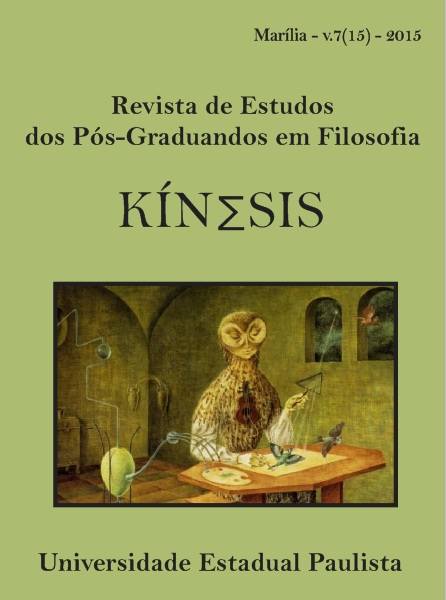THIRD GENERATION REPLICATORS: AN OVERVIEW OF THE BLACKMORIAN TEMES CONCEPTION
DOI:
https://doi.org/10.36311/1984-8900.2015.v7n15.5701Palavras-chave:
Temes, Memes, Cyborgs, Susan Blackmore, Richard DawkinsResumo
This article aims at presenting the theoretical foundation of the temes, the third generation replicators proposed by Susan Blackmore. Blackmore’s hypothesis is grounded on the premise that a novel evolution process is presently taking place on earth, in which the copy, variation and selection of information are carried out directly by the machines, and no longer by the genes and memes alone, thus bringing about an evolutionary algorithm in a different complexion. Naturally, a large part of Blackmore’s theoretical foundation stems from Richard Dawkins’s memetic theory, to which memes would be able to account for the cultural evolution pertaining to human beings. By scrutinising the notions of memes and temes, based on the battle of the replicators’ scenario imagined by Blackmore, this article intends, ultimately, to ponder upon the human condition, especially in regard to its relationship with the construct of the cyborg, at a moment in which the temes all but determine the merging of man and machine.Downloads
Referências
AUNGER. R. The electric meme: a new theory of how we think. New York: The Free Press. 2002.
BLACKMORE, S. Dangerous Memes; or, What the Pandorans let loose. Cosmos and Culture: Cultural Evolution in a Cosmic Context. NASA, p. 297-318, 2010. Disponível em: http://www.susanblackmore.co.uk/Chapters/cosmos2008.htm. Acesso em: 06 out. 2014
______. Losing our hands. What should we be worried about? John Brockman. New York, p. 306-309, 2014. Disponível em:
http://www.susanblackmore.co.uk/Chapters/Edge2014.htm. Acesso em: 06 out.2014
______. The Meme Machine. New York: Oxford University Press, 1999.
______. The third replicator is among us. New Scientist, August, p. 36-39. 2009. Disponível em: https://www.newscientist.com/article/mg20327191.500-evolutionsthird-replicator-genes-memes-and-now-what. Acesso em: 06 nov. 2015.
BROOKS, R. A. Cuerpos y máquinas: de lós robots humanos a lós hombres robots. Tradução de Guilhermo Solana. Barcelona: Domingraf, 2003.
BRUNO, F. Membras e Interfaces. In VILLAÇA, F., GÓES F., KOSOVSKI E. Que corpo é esse? Novas perspectivas. 2ª ed. Rio de Janeiro: Mauad, 1999.
DAWKINS, R. O Gene Egoísta. 8ª reimpressão. Tradução de Rejane Rubino. São Paulo: Companhia das Letras, 2007.
______. O Relojoeiro Cego: a teoria da evolução contra o desígnio divino. 7ª reimpressão. Tradução de Laura Teixeira Motta. São Paulo: Companhia das Letras, 2001.
DENNETT, D. Darwin´s Dangerous Idea: evolution and the meaning of life. New York: Simon & Schuster Paperbacks, 1995.
______. Quebrando o encanto: a religião como fenômeno natural. Tradução de Helena Londres. São Paulo: Globo, 2006.
HAYLES, N. Katherine. How we became posthuman: virtual bodies in cybernetics, literature, and informatics. Chicago: University of Chicago Press, 1999.
JABLONKA, E. & LAMB, M. J. Evolução em Quatro Dimensões. Tradução de Claudio Angelo. São Paulo: Companhia das Letras, 2010.
KURZWEIL. R. Como criar uma mente: os segredos do pensamento humano.Tradução de Marcello Borges. São Paulo: Aleph, 2014.
______. A Era das Máquinas Espirituais. Tradução Fábio Fernandes. São Paulo: Aleph, 2007.
LYNCH, A. Thought contagion: how belief spreads through society. New York: Basic Books, 1996.
MITHEN, S. J. A Pré-História da Mente: uma busca das origens da arte, da religião e da ciência. Tradução de Laura Cardellini Barboa de Oliveira; revisão técnica Max Blum Ratis e Silva. São Paulo: Editora UNESP, 2002.
MORAVEC, H. P. Mind children: the future of robot and human intelligence. Massachussetts: Harvard University Press, 1988.
REGIS, F. Nós, ciborgues: tecnologias de informação e subjetividade homem-máquina. Curitiba: Champagnat, 2012.
SANTAELLA, L. Corpo e comunicação: sintomas da cultura. São Paulo: Paulus, 2004.
SIBILIA, P. O homem pós-orgânico: corpo, subjetividade e tecnologias digitais. Rio de Janeiro: Relume Dumará, 2002.
TOMAZ, T (Org.). Antropologia do ciborgue: as vertigens do pós-humano. 2ª ed., 1ª. reimp. Belo Horizonte: Autêntica Editora, 2013.
TEIXEIRA, J. de F. A mente pós-evolutiva: a filosofia da mente no universo do silício.Petrópolis, RJ: Vozes, 2010.
______. Inteligência artificial. São Paulo: Paulus, 2009.
Downloads
Publicado
Edição
Seção
Licença
Copyright (c) 2016 Kínesis - Revista de Estudos dos Pós-Graduandos em Filosofia

Este trabalho está licenciado sob uma licença Creative Commons Attribution-NonCommercial-ShareAlike 4.0 International License.





